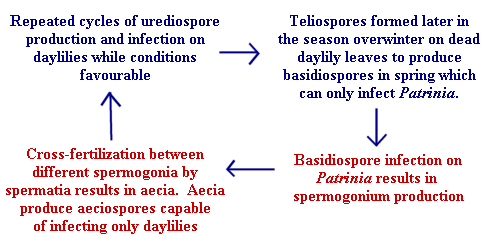DAYLILLY RUST
Rust
on daylilies is a complex disease which goes through several
different life cycle stages. Part of the life cycle
takes place on daylilies and part on another Asian perennial
plant known as Patrinia.
A diagram of the life cycle appears below with the stages on
daylily in blue, and those on Patrinia
in red. A more detailed (but still somewhat simplified)
description of the different stages follows the diagram.

On
daylilies, the rust produces two spore types, urediospores and
teliospores. A spore is a reproductive unit capable of
germination and growth, somewhat similar to a plant seed.
The repetition of infection on daylilies by urediospores alone
is an asexual (cloning) method of reproduction which serves to
build up the level of disease. The rust also has a form of
sexual reproduction which cannot be completed without the
alternate host, Patrinia.
Both hosts are needed to fully complete the life cycle of this
rust, although the rust can overwinter without the sexual
cycle where conditions permit.
-
A
daylily plant's first infection starts when a urediospore
from a daylily or an aeciospore from Patrinia
lands on a leaf, then grows and feeds inside the living
leaf in the form of mycelium (fungal strands), eventually
producing a mass of urediospores which erupt outwards
through the leaf's epidermis ("skin").
-
These
urediospores are also known as "repeating"
spores or "summer" spores, and are spread mostly
by the wind to leaves of daylily plants to cause more
infection and produce more urediospores.
-
Cycles
of urediospore infection and production can continue on
daylilies indefinitely under suitable environmental
conditions. However, the urediospores cannot infect
Patrinia.
-
Later
in the season, the rust prepares to overwinter by
producing another type of spore called teliospores, also
known as "winter" spores because they are
typically tougher and more resistant to cold temperatures
than urediospores. Teliospore masses (telia) first
appear as darkened areas around the more familiar orange
spots containing urediospores, and then turn black.
Other methods by which rusts can overwinter are as dormant
mycelium and, less commonly, urediospores.
-
Teliospores
pass the winter in a dormant state on the dry, dead
daylily leaves. In warm climates, teliospores do not
appear to be necessary for winter survival of the rust
since the asexual stage can continue through the winter.
-
In
the spring, the teliospores germinate on the dead daylily
leaves to produce basidiospores. Basidiospores
cannot infect daylilies and must instead infect the
alternate host, Patrinia.
-
The
basidiospores produced on daylily leaves in spring are
carried by wind, or other means, to Patrinia where they result
in the production of dark spots called spermogonia or
pycnia.
-
Spermogonia
produce spermatia (also called pycniospores) which
fertilize receptive hyphae in spermogonia of the opposite
mating type.
-
Successful
fertilization leads to the production of structures known
as aecia on the other side of the Patrinia
leaf.
-
These
aecia produce another spore type, aeciospores which cannot
re-infect Patrinia but must return
to daylilies via the wind or other means.
-
When
the aeciospores land on daylilies and environmental
conditions are suitable, they germinate and penetrate the
leaf resulting in mycelium again growing inside the
daylily leaf.
-
Later,
masses of urediospores erupt through the leaf epidermis to
re-start the cycle described above.
Note:
Rusts are "obligate parasites" which means that
their mycelium can only grow and feed in living plant tissue.
The spores, on the other hand, can live independently of live
plants for varying periods of time. The longevity of the
different spore types of daylily rust is not yet known.
In order to germinate and infect, however, urediospores,
basidiospores and aeciospores must land on living plant parts
and experience suitable conditions of moisture and
temperature. The requirements for urediospore
germination are discussed in other links on this site.
In contrast, teliospores do not need living tissue on which to
germinate and produce basidiospores.
It
is not yet known where and by which method daylily rust will
overwinter in the different regions of North America, although
it did successfully overwinter in Florida in 2000/1 and
2001/2. Only urediospores and teliospores have been reported
since the rust was first identified in North America in August
2000 - the teliospores were present in Florida1
and Georgia2. Puccinia
hemerocallidis was
first recorded in 1880 in Siberia, Russia3.
The spermogonial/aecial stage on Patrinia,
and its relationship to rust on daylilies, has been documented
in Russia (Tranzschel, 1913)4
and Japan (Hiratsuka, 1938)4.
Reprinted from an
article by
Susan Bergeron -
http://www.ncf.ca/~ah748/lifecycle.html
1Florida
Department of Agriculture - includes images
2Research
by Dr. Williams-Woodward and Dr. Buck (SNA site)
3Record
of Daylily Rust in Siberia in 1880
4Hiratsuka, N., Sato, T., Katsuya, K., Kakishima,
M., Hiratsuka, Y., Kaneko, S., Ono, Y., Sato, S., Harada, Y.,
Hiratsuka, T., and Nakayama, K. 1992. The Rust Flora of
Japan. Tsukuba Shuppankai, Ibaraki, Japan. Pages
710-711.
|
.gif)

![]()


.gif)
